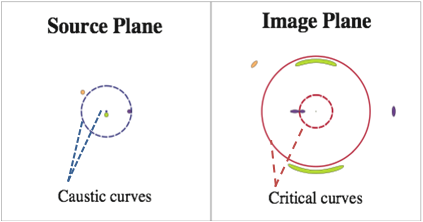
A softened isothermal sphere lens and an extended source
In this case the lens is not a point-mass, but a galaxy. A simple model for lens galaxies is the softened isothermal sphere, which assumes that the stars and other components forming the galaxy behave like particles of an ideal gas confined by a spherically symmetric potential. The galaxy has a core, whose angle is θc. The deflection angle and the deflection potential are

and

The lens equation is

Using the deflection potential we get that there are two critical curves, with their corresponding caustics. The magnification caused by a lens with circular symmetry can be written as

and substituting β and its partial derivative we get the
expression for this specific case.
In the following figure we can see
that the green source is inside a caustic, so it produces three images
(two tangential arcs and a point image in the center), as it was
explained before. If it approaches the outermost caustic, like the
purple source, two of the images merge and form a single one. The orange
source is outside all caustics and has only one image.

As the angles implied are really small we multiply them, and so the equations in which they appear, by 2*105. The effect is the same as if we look to the sky through a telescope.